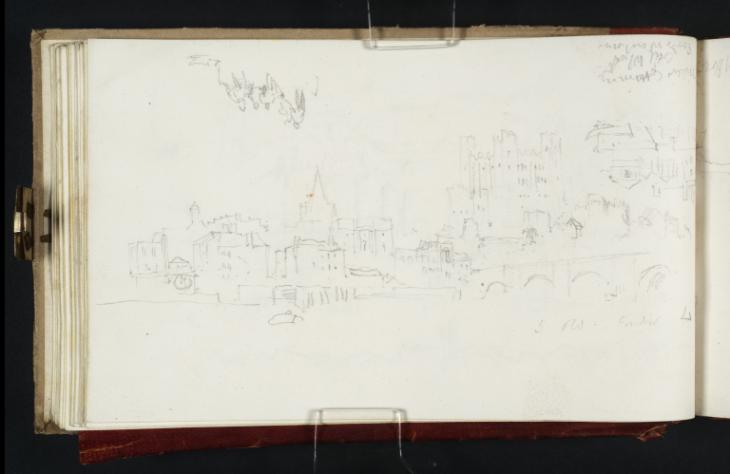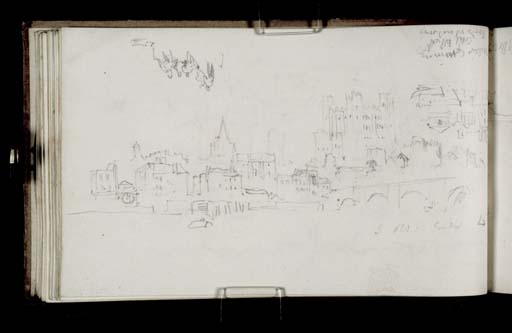Joseph Mallord William Turner Rochester from the Northern Bank of the River Medway c.1821
Image 1 of 2
Joseph Mallord William Turner,
Rochester from the Northern Bank of the River Medway
c.1821
Joseph Mallord William Turner 1775–1851
Folio 18 Verso:
Rochester from the Northern Bank of the River Medway c.1821
D17395
Turner Bequest CXCIX 18a
Turner Bequest CXCIX 18a
Pencil on white wove paper, 112 x 190 mm
Turner Bequest CXCIX 18a
Partial watermark ‘nard | 20’
Inscribed by Turner in pencil ‘5 SW [...] 4’ towards bottom right, ‘[?Me...G]’, ‘[?C...What]’, ‘Goods Warehouse’ top right, upside down
Turner Bequest CXCIX 18a
Partial watermark ‘nard | 20’
Inscribed by Turner in pencil ‘5 SW [...] 4’ towards bottom right, ‘[?Me...G]’, ‘[?C...What]’, ‘Goods Warehouse’ top right, upside down
Accepted by the nation as part of the Turner Bequest 1856
Exhibition history
1997
Turner’s Watercolour Explorations 1810–1842, Tate Gallery, London, February–June 1997, Southampton City Art Gallery, June–September (57, reproduced).
1999
Turner’s Later Papers: A Study of the Manufacture, Selection and Use of his Drawing Papers 1820–1851, Tate Gallery, London, March–June 1999 (12, reproduced).
2002
Turner’s Picturesque Travels: Engraved Views of Britain, Tate Britain, London, March–August 2002 (no catalogue).
References
1909
A.J. Finberg, A Complete Inventory of the Drawings of the Turner Bequest, London 1909, vol.I, p.608, CXCIX 18 a, as ‘Shipping, &c., at Rochester. See Water Colour (420 N.G.) engraved in “River Scenery,” and published 1 January, 1824.’.
1979
Andrew Wilton, J.M.W. Turner: His Life and Work, Fribourg 1979, p.385 under no.735.
1980
Michael Spender and Malcolm Fry, Turner at the Bankside Gallery: Catalogue of an Exhibition of Drawings & Water-colours of British River Scenes from the British Museum, exhibition catalogue, Bankside Gallery, London 1980, p.120 under no.55.
1991
Ian Warrell, Turner: The Fourth Decade: Watercolours 1820–1830, exhibition catalogue, Tate Gallery, London 1991, p.31 under no.11.
1997
Eric Shanes, Turner’s Watercolour Explorations 1810–1842, exhibition catalogue, Tate Gallery, London 1997, p.71 no.57, reproduced.
1999
Peter Bower, Turner’s Later Papers: A Study of the Manufacture, Selection and Use of his Drawing Papers 1820–1851, exhibition catalogue, Tate Gallery, London 1999, pp.39–40 no.12, reproduced (with ‘micrograph’ detail).
The predominant drawing on this page displays a view of Rochester from the northern bank of the River Medway. The handling is detailed and the pencil hard. Lines are finely considered and windows in the castle and waterfront buildings meticulously recorded.
As recognised by Finberg, this page is one of four preparatory studies in the present sketchbook for the watercolour Rochester, on the River Medway of 1822 (Tate D18156; Turner Bequest CCVIII W),1 which was engraved by Thomas Lupton for the Rivers of England series and published in January 1824 (Tate impressions T06370, T04796–T04798).2 Ian Warrell groups this page alongside folios 10 recto, 18 recto, and 19 recto (D17381, D17394, D17396) as those which directly influenced the finished composition.3
At top left, made with the sketchbook turned upside down according to its foliation, Turner observes a group of men, seemingly engaged inside a small boat. The three men at right appear seated, hauling in ropes or nets with their arms extended over the side of the vessel. Further left, one or perhaps two additional figures can be seen standing up. The boat itself is largely unarticulated.
Also evident on this sheet is a small section of the drawing which dominates the facing page on folio 19 recto (D17396). For an explanation of the expansive scene, which again describes Rochester, see the entry for that page. Composed with the sketchbook inverted according to foliation, the section visible here is close to the gutter and describes small fishing boats and harbour buildings on the waterfront.
Peter Bower reproduces an image of this page to illustrate the quality and nature of the Thin Post wove writing paper and watermarks in Turner’s Post Octavo notebooks, in this case produced by Richard Barnard of Hollingbourne.4 For further information see the Technical Notes in the Introduction to this sketchbook. For more expansive discussion about critical attitudes towards this and the other preparatory sketches of Rochester, see the entry for folio 18 recto (D17394).
Technical notes:
This page has been cut from the sketchbook and pasted back in. There is a single neat join visible close to the gutter.
Maud Whatley
January 2016
How to cite
Maud Whatley, ‘Rochester from the Northern Bank of the River Medway c.1821 by Joseph Mallord William Turner’, catalogue entry, January 2016, in David Blayney Brown (ed.), J.M.W. Turner: Sketchbooks, Drawings and Watercolours, Tate Research Publication, February 2017, https://www


